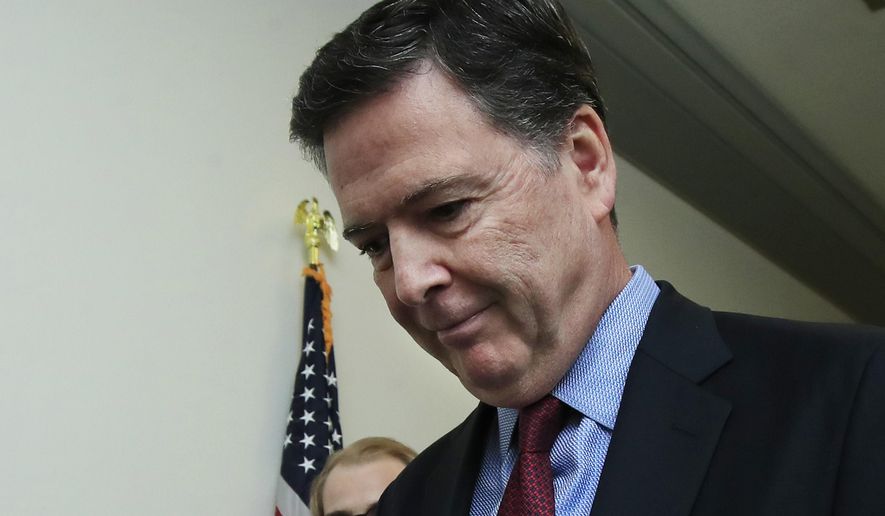Former FBI Director James B. Comey testified that he knew little about the Democratic Party-financed dossier on which his agents relied to obtain wiretaps on a Trump campaign volunteer and target other Republicans in an ongoing 28-month investigation.
In House testimony released Saturday, Mr. Comey said he didn’t learn specifically who funded it or whether it was ever corroborated.
The dossier was funded by the Hillary Clinton campaign and her party, and written by British ex-spy Christopher Steele. He was paid through the Democrats’ law firm, Perkins Coie, and investigative firm Fusion GPS. The Clinton campaign didn’t disclose its relationship with Mr. Steele on campaign finance reports for the Federal Election Commission.
Republicans considered the dossier an opposition research hoax that never should have been relied on by the FBI. Mr. Steele spread his allegations to news reporters, Democrats and the Justice Department. He made a series of election conspiracy charges against President Trump and associates that have yet to be proven publicly.
Mr. Steele cited a number of Moscow intelligence and diplomatic sources, prompting conservatives to say Mr. Trump has been the victim of Kremlin disinformation.
Mr. Comey, fired by Mr. Trump in May 2017, underwent hours of closed testimony Friday before a joint task force of the House Judiciary and Oversight committees.
Rep. Trey Gowdy, South Carolina Republican, asked him a stream of questions about how the dossier memos were used in one of the most important investigations in FBI history — targeting a presidential campaign.
Mr. Comey testified that many dossier details were handled by agents, not him.
As director, he said he didn’t know:
• Mr. Steele himself.
• How his information exactly reached the FBI.
• That the FBI fired him for leaking to the news media against its guidelines.
• That Mr. Steele continued to pump anti-Trump information to the FBI via Bruce Ohr, an associate deputy attorney general. Mr. Ohr’s wife worked at Fusion GPS as a Russia expert investigating Mr. Trump.
• That the DNC, through Perkins Coie, funded Mr. Steele.
• Whether parts of the dossier were ever corroborated.
“How long did [Mr. Steele] have a relationship with the FBI?” Mr. Gowdy asked at one point, according to a transcript of the testimony.
“I don’t know,” Mr. Comey said. “I never met him, never spoken to the man.”
Asked when did he learn that Mr. Steele worked for Fusion GPS, Mr. Comey said, “I don’t know that I ever knew that I think I’ve read that in open source, but I didn’t know that while I was FBI.”
Mr. Comey said he was first briefed on the material in September/October 2016 and heard that it had come in some way from Democrats.
This was a key time frame because the FBI decided to seek a wiretap on Trump campaign volunteer Carter Page that October. Agents used the dossier as their key piece of evidence. Their application to a federal judge said Mr. Steele’s charges were corroborated by a Yahoo News story that in fact had been sourced by Mr. Steele.
Asked when did he learn that Fusion GPS was hired by Perkins Coie, Mr. Comey said, “I never learned that.”
Asked when did he learn that the DNC had hired Perkins Coie, he said, “I never learned that while I was director.”
Mr. Gowdy: While you were the director, you never knew that the DNC hired a law firm that hired an oppo research firm that hired Christopher Steele?
Mr. Comey: No, I don’t think.
Mr. Comey depicted the investigate in 2016 as not into the Trump campaign but into “four Americans.”
“Who paid and the particulars of who paid would be important to people working the case, but the level of specificity that the director needed to know is, to my mind, a different question,” the former FBI director testified.
Mr. Gowdy noted that Mr. Comey signed warrants to spy on Mr. Page that included dossier allegations. (Though not mentioned Friday, the FBI also paid an informant that summer to spy on Mr. Page and another Trump campaign worker, George Papadopoulos.)
Mr. Gowdy: How did Chris Steele’s information reach the FBI?
Mr. Comey: I don’t know for sure. I have some recollection that he passed it to an agent that he knew and that that agent sent it on to headquarters.
Mr. Gowdy: How did the bureau investigate whatever information Steele provided?
Mr. Comey: I don’t know in particular. I know that the Counterintelligence Division was investigating various aspects of the reports he had supplied, and that investigation was ongoing when I was fired.
Mr. Gowdy then asked about Mr. Steele’s sources, whom the ex-spy identified as Kremlin figures.
Mr. Comey: I have a recollection that there were a variety of sources and subsources, but I don’t have a sense of the scope.
Mr. Gowdy: Do you have a sense that the bureau was able to identify every source and subsource Steele relied upon?
Mr. Comey: I don’t know one way or another.
Mr. Comey decided to brief President-elect Trump, one-on-one, on the dossier at Trump Tower in January 2017. Mr. Comey said he heard CNN was preparing a story and that Mr. Trump needed to know the salacious parts.
• Rowan Scarborough can be reached at rscarborough@washingtontimes.com.




Please read our comment policy before commenting.